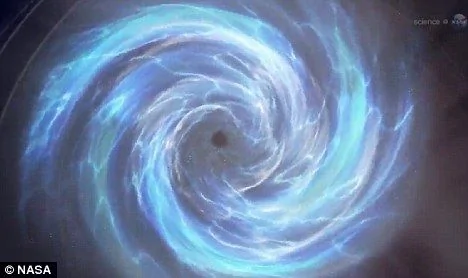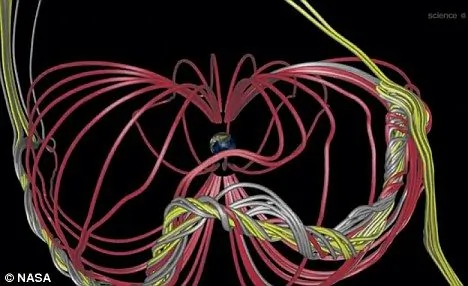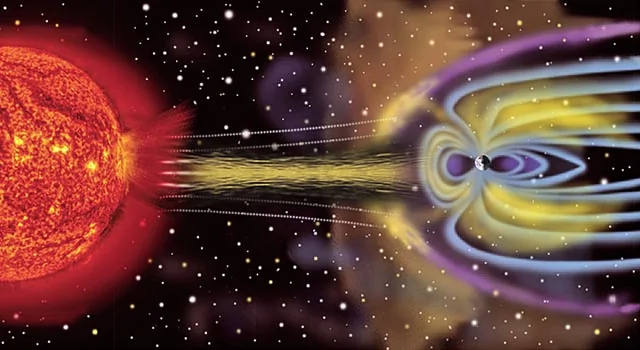
美国科学家在地球与太阳之间的太空区域发现隐藏的“入口”,被称之为“X点”或者“电子扩散区”

地球与太阳之间的磁力线,穿过X点/新浪科技

科学家指在地球外围有几个隐藏「磁场传送门」,是来往太阳及地球的捷径。
多啦A梦的随意门,未必是科幻小说或漫画的情节,美国科学家发现地球磁场有几个隐藏的「磁场传送门」,时开时关,一旦出现,就会提供由地球直达太阳捷径。太空总署( NASA)计划深入研究这道传送门,一旦成功,可能为人类提供时空旅游之门。
艾奥瓦大学科学家斯卡德( Jack Scudder)说,在地球16,000至48,000公里外的磁场发现多个隐藏的磁场传送门,称为「 X点」或「电子扩散区」( Electron diffusion region)。这些 X点「看不见,也不稳定,会毫无预警地开关」,有时每天开关几十次,一旦开启,就会製造一条由地球直接抵达太阳的捷径,一下子缩短近1.5亿公里的距离,让太阳粒子不受干扰地直抵地球。由太阳飘浮过来的带磁电粒子,令地球的大气层有电磁现象,形成极光甚至地磁风暴。
NASA拟监看 X点
NASA极地衞星在十年前已瞥见 X点,署方形容 X点是「宇宙或时空中的不寻常通道,联繫旅行者与遥远界域,亦是通往未知之门」。 NASA宣佈在2014年,展开「磁层多尺度测量行动」,发射四艘可测量磁场组合与能量粒子的探测船,环绕地球监看 X点开关。
英国《每日邮报》/Guardian Express(香港苹果日报编译)
地球磁场 有任意门通太阳 NASA新发现 「时空旅行有谱」
美国科学家发现能量可快速通往太阳的入口。
自由穿越时间与空间是科幻小说的常见元素,日本漫画《哆啦A梦》也有个来去自如的任意门,如今这种奇想可能成真。美国研究发现,确有传送能量的「磁场任意门」存在,能以极高速往来地球与太阳间,像是地球磁场的「神祕通道」,可直达太阳表面。
美国航太总署(NASA)和爱荷华大学合作研究,分析NASA正义号(THEMIS)和极地号(Polar)卫星探测所得数据,加上欧洲太空总署(ESA)的群簇卫星,发现在离地球数万公里之处,有多处「电子扩散区」(electron diffusion regions)、又称「X点」的存在,每天开关数十次,作用像是地球与太阳间的捷径入口。
每天开关数十次
爱荷华大学教授史卡德(Jack Scudder)指出,这些入口位于地球磁场和太阳磁场相连处,在两地间创造出毫无阻碍的直通路径。这些入口不但不显眼,存在也不稳定且难辨识,每天开关数十次,但开启和关闭时皆无迹象可循。但若入口开启,便能以极高速传送能量到1.5亿公里外的太阳,也因速度极快而引发地磁风暴。
持续时间不确定
不过史卡德表示,研究团队虽发现通道间有带电粒子,但仍无法确定神祕入口的组成元素为何。此外,入口的持续时间也不相同,有些入口快速出现又消失,有些则维持较久。
NASA预计2014年启动「磁气圈多尺度测量计划」(MMM),将派遣4艘太空船环绕地球,监看「磁场任意门」的开启情形,试图解开磁场交界何以形成通道的原理。

英国物理学家霍金3年前曾祕密举办一场派对,证明时空旅行不存在。资料照片
霍金仍嗤之以鼻
宇宙中有「磁场任意门」,令科学家和天文迷大为兴奋,彷彿离时空旅行更进一步,但英国知名物理学家霍金(Stephen Hawking)却对时空旅行嗤之以鼻。日前流出的一段影片显示,霍金曾于2009年6月28日举办一场「欢迎时空旅行者」派对。派对讯息事前保密到家,以防恶作剧者捣乱,直至结束后才发出邀请函。
霍金认为,如果时空旅行真的存在,那麽就算是事后才收到邀请,也有办法回到过去与他相会。但影片显示,在备有香槟和点心、以鲜花和气球装饰的会场中,霍金始终独自一人。他说:「我用实验证明,时空旅行并不存在。」

磁场任意门示意图
磁场任意门入口位于地球磁场和太阳磁场相连处,每天开关数十次,入口开启便能以极高速传送能量到1.5亿公里外的太阳。 (台湾苹果日报 庄蕙嘉╱综合报导)
视频解说词如下:
Hidden Portals in Earth's Magnetic Field
A favorite theme of science fiction is "the portal"--an extraordinary opening in space or time that connects travelers to distant realms. A good portal is a shortcut, a guide, a door into the unknown. If only they actually existed....
It turns out that they do, sort of, and a NASA-funded researcher at the University of Iowa has figured out how to find them.
"We call them X-points or electron diffusion regions," explains plasma physicist Jack Scudder of the University of Iowa. "They're places where the magnetic field of Earth connects to the magnetic field of the Sun, creating an uninterrupted path leading from our own planet to the sun's atmosphere 93 million miles away."
Observations by NASA's THEMIS spacecraft and Europe's Cluster probes suggest that these magnetic portals open and close dozens of times each day. They're typically located a few tens of thousands of kilometers from Earth where the geomagnetic field meets the onrushing solar wind. Most portals are small and short-lived; others are yawning, vast, and sustained. Tons of energetic particles can flow through the openings, heating Earth's upper atmosphere, sparking geomagnetic storms, and igniting bright polar auroras.
NASA is planning a mission called "MMS," short for Magnetospheric Multiscale Mission, due to launch in 2014, to study the phenomenon. Bristling with energetic particle detectors and magnetic sensors, the four spacecraft of MMS will spread out in Earth's magnetosphere and surround the portals to observe how they work.
Just one problem: Finding them. Magnetic portals are invisible, unstable, and elusive. They open and close without warning "and there are no signposts to guide us in," notes Scudder.
Actually, there are signposts, and Scudder has found them.
Portals form via the process of magnetic reconnection. Mingling lines of magnetic force from the sun and Earth criss-cross and join to create the openings. "X-points" are where the criss-cross takes place. The sudden joining of magnetic fields can propel jets of charged particles from the X-point, creating an "electron diffusion region."
To learn how to pinpoint these events, Scudder looked at data from a space probe that orbited Earth more than 10 years ago.
"In the late 1990s, NASA's Polar spacecraft spent years in Earth's magnetosphere," explains Scudder, "and it encountered many X-points during its mission."
Data from NASA's Polar spacecraft, circa 1998, provided crucial clues to finding magnetic X-points. Credit: NASA
Because Polar carried sensors similar to those of MMS, Scudder decided to see how an X-point looked to Polar. "Using Polar data, we have found five simple combinations of magnetic field and energetic particle measurements that tell us when we've come across an X-point or an electron diffusion region. A single spacecraft, properly instrumented, can make these measurements."
This means that single member of the MMS constellation using the diagnostics can find a portal and alert other members of the constellation. Mission planners long thought that MMS might have to spend a year or so learning to find portals before it could study them. Scudder's work short cuts the process, allowing MMS to get to work without delay.
It's a shortcut worthy of the best portals of fiction, only this time the portals are real. And with the new "signposts" we know how to find them.



















